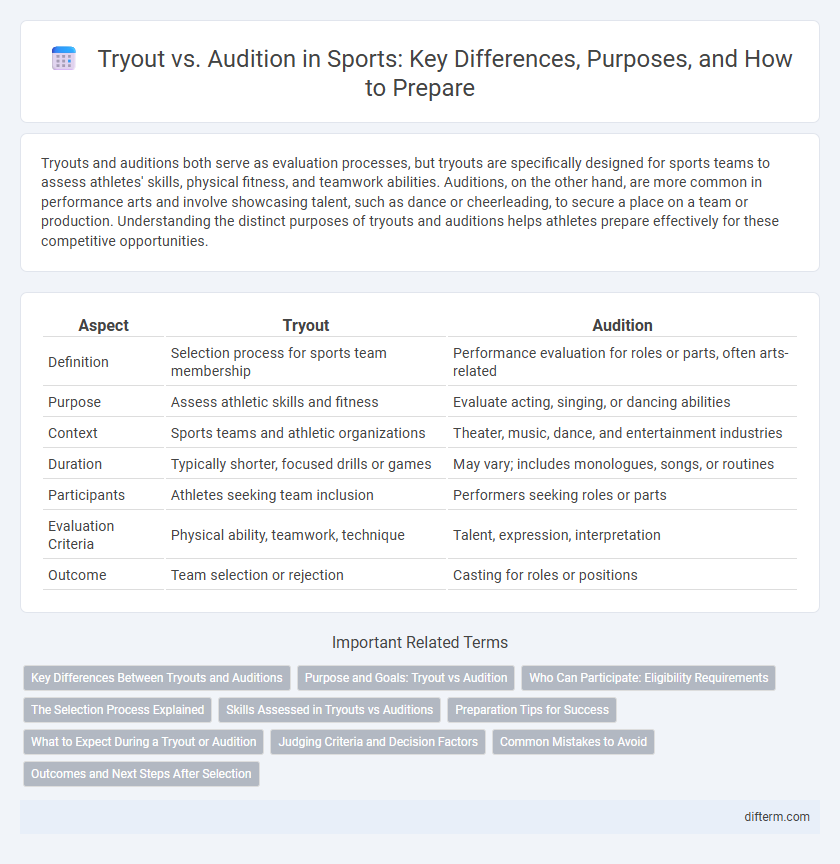Tryouts and auditions both serve as evaluation processes, but tryouts are specifically designed for sports teams to assess athletes' skills, physical fitness, and teamwork abilities. Auditions, on the other hand, are more common in performance arts and involve showcasing talent, such as dance or cheerleading, to secure a place on a team or production. Understanding the distinct purposes of tryouts and auditions helps athletes prepare effectively for these competitive opportunities.
Table of Comparison
| Aspect | Tryout | Audition |
|---|---|---|
| Definition | Selection process for sports team membership | Performance evaluation for roles or parts, often arts-related |
| Purpose | Assess athletic skills and fitness | Evaluate acting, singing, or dancing abilities |
| Context | Sports teams and athletic organizations | Theater, music, dance, and entertainment industries |
| Duration | Typically shorter, focused drills or games | May vary; includes monologues, songs, or routines |
| Participants | Athletes seeking team inclusion | Performers seeking roles or parts |
| Evaluation Criteria | Physical ability, teamwork, technique | Talent, expression, interpretation |
| Outcome | Team selection or rejection | Casting for roles or positions |
Key Differences Between Tryouts and Auditions
Tryouts primarily assess an athlete's physical skills, endurance, and game understanding to determine team placement, while auditions evaluate performers' artistic abilities, stage presence, and interpretation. Tryouts often involve competitive drills and scrimmages, emphasizing measurable athletic performance, whereas auditions focus on creativity, expression, and adherence to artistic direction. The selection criteria differ significantly, with tryouts centered on athletic capability and teamwork, and auditions prioritizing talent, versatility, and emotional impact.
Purpose and Goals: Tryout vs Audition
Tryouts primarily aim to evaluate an athlete's skills, physical fitness, and teamwork to secure a spot on a sports team, emphasizing competitive performance and potential contribution. Auditions focus on assessing an individual's talent and ability to perform specific routines or roles, often highlighting artistic expression and technique in sports like gymnastics or figure skating. Both processes serve to identify suitable candidates but differ in assessing athletic prowess versus artistic presentation within sports contexts.
Who Can Participate: Eligibility Requirements
Tryouts are typically designed for athletes who meet specific age, skill, or experience criteria set by sports teams or organizations, ensuring participants have a foundational level of proficiency. Auditions, on the other hand, often target individuals with performance skills relevant to sports entertainment or dance teams, with eligibility based on prior training or performance experience. Both tryouts and auditions require participants to demonstrate abilities that align with the selection goals, but eligibility rules vary according to the nature of the sport or performance group.
The Selection Process Explained
Tryouts in sports focus on evaluating physical skills, athletic performance, and teamwork under competitive conditions to select the best candidates for a team. Auditions, more common in performing arts, assess individual talent, technique, and artistic interpretation, often through rehearsed routines. The selection process in tryouts relies heavily on measurable criteria such as speed, strength, and game strategy, whereas auditions prioritize creativity and expressiveness.
Skills Assessed in Tryouts vs Auditions
Tryouts primarily assess athletic abilities such as physical fitness, sport-specific skills, teamwork, and strategic understanding relevant to the sport. Auditions focus on artistic skills including performance ability, creativity, expression, and technical proficiency in areas like dance, music, or acting. Both processes evaluate discipline and preparation but emphasize different skill sets tailored to sports or performing arts.
Preparation Tips for Success
Effective preparation for sports tryouts involves focused physical conditioning, mastering fundamental skills, and studying team strategies specific to the sport. Audition preparation requires honing technical proficiency, showcasing versatility, and understanding the coach's or selector's criteria to meet artistic or performance standards. Both require mental resilience, proper nutrition, and consistent practice to maximize success chances.
What to Expect During a Tryout or Audition
During a sports tryout, athletes experience skill assessments, physical fitness tests, and team drills designed to evaluate their abilities and potential fit within the team. Auditions, more common in performance-based sports like gymnastics or figure skating, emphasize technical execution, artistic expression, and routine presentation under evaluators' scrutiny. Both processes demand physical readiness, mental focus, and a demonstration of commitment to excel.
Judging Criteria and Decision Factors
Tryouts in sports primarily assess athletic skills, physical fitness, and teamwork abilities through objective drills and performance metrics. Auditions, while less common in sports, emphasize individual technique, presentation, and adaptability to specific roles or positions. Coaches and scouts prioritize consistency, potential for development, and mental resilience when making final decisions between candidates.
Common Mistakes to Avoid
Confusing tryouts with auditions often leads to improper preparation, as tryouts typically emphasize physical performance and skill demonstration, whereas auditions focus on artistic or expressive abilities. A common mistake is neglecting the specific criteria set by coaches or selectors, resulting in overlooked key performance indicators during a tryout or ignoring presentation nuances in an audition. Understanding the distinct objectives and expectations of each process enhances an athlete's or performer's chances of success.
Outcomes and Next Steps After Selection
Tryouts determine an athlete's eligibility for a team based on performance metrics and skill evaluation, leading to roster inclusion or further training recommendations. Auditions assess an athlete's suitability for specific roles or positions, often resulting in immediate casting decisions or invitations to advanced workshops. Successful participants in both processes receive feedback on performance, with next steps typically involving contract signings, practice schedules, or additional assessments.
tryout vs audition Infographic

 difterm.com
difterm.com